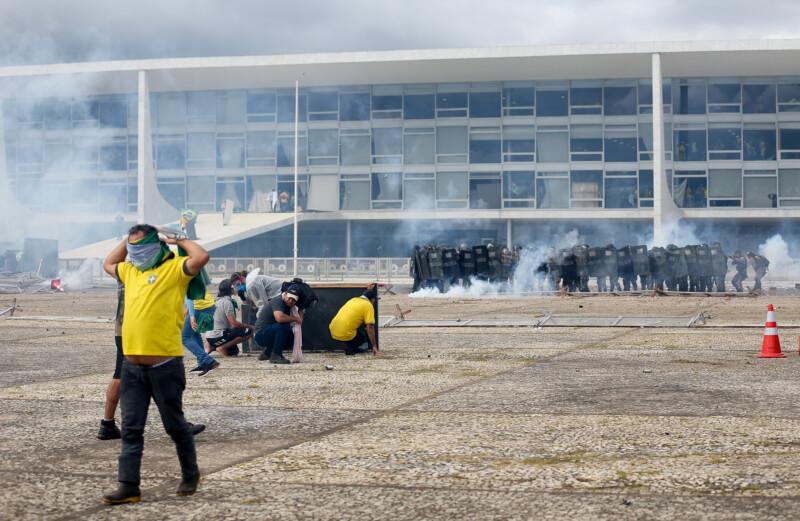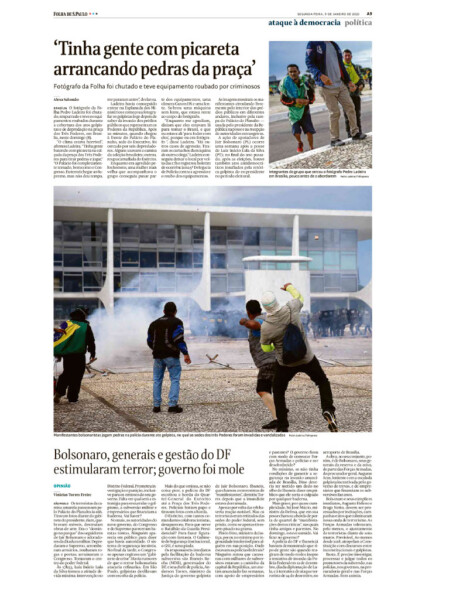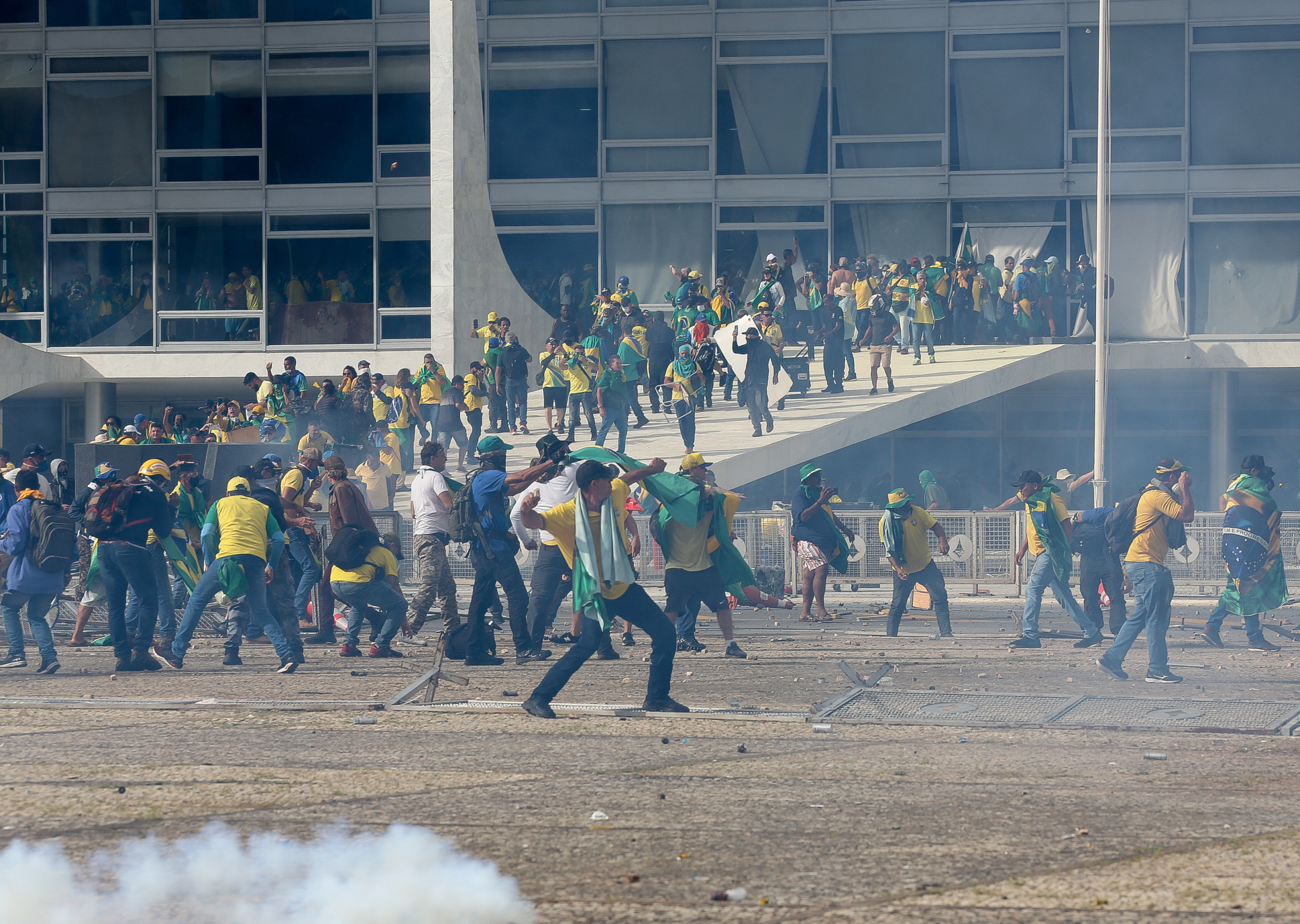On January 8 of this year Pedro Ladeira, a photographer for the newspaper Folha de S.Paulo, was celebrating his son’s seventh birthday in Brazil’s capital, Brasília, when his editor messaged. Thousands of supporters of far-right president Jair Bolsonaro had violently breached the Supreme Court, Congress, and presidential palaces, he was told.
“I have to work. There’s a demonstration,” Ladeira recalled telling his son.
When Ladeira arrived at the Monumento Os Candangos, a 1959 bronze statue paying tribute to the workers who built Brazil in the central government plaza, it felt like the country was being ripped apart. Ladeira tried to document a chaotic scene as police fired tear gas and rubber bullets at protesters intent on causing destruction. Bolsonaro, who had lost a bid for reelection, had spent years undermining confidence in Brazil’s electoral infrastructure, and his supporters refused to accept left-wing former president Luiz Inácio Lula da Silva’s election victory.
Ladeira was surrounded by seven people wearing army camouflage and yellow shirts. “They started screaming, ‘He’s a journalist! He’s the enemy! He wants to fuck us with those photos!’” Ladeira said. “They took my equipment, they pushed me, they kicked me.”
Ladeira said the rioters grabbed and stole one camera and broke the lens of another, taking with them many of the photos of the insurrection, before he managed to get away around 5pm. “I felt afraid for my life in this moment,” he said. But alongside fear and terror, Ladeira felt a profound sadness seeing people destroy Brazil’s monuments, buildings, and artworks. “With all this fake news and hate speech, it was very sad to see where it ends,” he added.
The attack on Brazilian democracy echoes events on the steps of the US Capitol on January 6, 2021, when rioters struck at the heart of American democracy. By attacking the integrity of Brazil’s electronic-voting infrastructure, Bolsonaro and his allies helped stoke a panic about a stolen election that resulted in a coup attempt.
For Joe Mulhall, director of research at antifascism organization HOPE Not Hate, who was in Brazil on the eve of the election, the similarities between January 6, 2021 and January 8, 2023, crystallized the way the global far right operates in the current digital media landscape—sharing tactics, strategies, narratives, and organizing tips from an amorphous online “swamp.” It stretches far beyond the Americas, too, with the emergence of a digital landscape that encompasses the UK, Hungary, France, and New Zealand, to name just a few.
In the US, Bolsonaro’s big lie was amplified by many of the same pro-Trump voices, such as Fox News host Tucker Carlson and former Donald Trump adviser Steve Bannon. Carlson told viewers it “was very clearly a rigged election.” “Lula stole the Election,” Bannon said on Gettr, calling pro-Bolsonaro protesters “freedom fighters.” “They’re blatantly attempting to STEAL the election from President Bolsonaro. Pray! Protest!” urged “Stop the Steal” protests founder Ali Alexander on Telegram.
The roots of connection between the US and the international far right run deep. “Steve Bannon and Tucker Carlson are leading the US right wing media in terms of interest in the global right,” John Knefel, senior writer at the nonprofit Media Matters for America, told me. For instance, Hungary’s authoritarian leader, Viktor Orbán, and Bolsonaro have appeared on Carlson’s show, and Bannon has tried to build networks between anti-immigration parties like the French National Rally, Austria’s Freedom Party, and Italy’s League.

Pedro Ladeira captured clashes between protesters and police, as Bolsonaro supporters look on from inside the stormed Brazilian Congress building in Brasília. Photo: Pedro Ladeira/Folhapress
Yet these connections at the top-tier political level only explain so much about the apparent explosion of far-right actors in recent years. Deeper, structural changes have also facilitated the right’s momentum.
The recent rise of alternative platforms—explicitly right-leaning sites such as Gab, Gettr, Truth Social, and Parler but also encrypted-chat apps like Telegram and Signal—has given the far right a solid base for organizing away from mainstream tech platforms, like Facebook and Twitter, which are more subject to scrutiny and have at least some content moderation policies.
They are all platforms where right-wing content has found a permanent home and “allow conservatives to reinforce their beliefs and fall deeper into an echo chamber,” Knefel said. In the run-up to the midterm elections at least sixty-nine million people had joined platforms such as Parler, Gab, Truth Social, Gettr, and Rumble, reported the New York Times, citing company statements. The lifeboats are permanently docked just offshore.
That has accelerated the growth of what Mulhall describes as the “post-organizational far right”—the digital media ecosystem means far-right actors can collaborate without the need for traditional party structures. In this new environment, “the weather is made by figureheads” such as Bannon, Mulhall said, but they cannot control the rank and file as previous generations of postwar far-right leaders could, with their membership cards and party diktats.
Instead, “it’s like this membrane that circles the globe, like synapses, between which ideas, ideology, tactics spread between networks,” Mulhall told me. Even supposedly “lone wolf” actors, like the white supremacist who killed fifty-one people in Christchurch, New Zealand, are drawing from an online global subculture. “It’s essentially mosquitoes emerging out of the swamp. They may look [like] individual [lone actors], they may look like there’s one of them, but they’re coming out…of these networks” online, Mulhall said.
The images Ladeira escaped with ran in Folha de S.Paulo the next day. They paint a picture of a nation at war with itself. “It’s something I always like to capture. [What] always attracts me in photos is movement and action,” he said, “especially in an event like this that was so chaotic, with people running, struggling with police, throwing stones, these kinds of things.”

After escaping the mob, Pedro Ladeira’s photography ran in the newspaper Folha de S.Paulo the next day. Photo: Pedro Ladeira/Folhapress
While Ladeira was being mobbed by Bolsonaro supporters in Brasília, BBC national digital reporter Mike Wendling, who specializes in disinformation and is the author of Alt-Right: From 4chan to the White House, was watching the New England Patriots play the Buffalo Bills on his couch in Chicago. At 2:40pm Central Time, his editor sent him a message.
Within minutes he was working on liveblog posts covering the violence, collaborating with BBC colleagues across Brazil, the US, and the UK to a vast audience. In many ways, the global nature of Wendling’s newsroom on January 8 resembles the links between the internationalist far right they were covering: connections between actors across continents. Wendling wrote a quickfire story on the connections between pro-Trump and pro-Bolsonaro activists.
“The pattern of events, the way they could build a movement by sowing seeds of doubt in the electoral process,” Wendling told me, “a lot of this stuff was copied and pasted wholesale” from the 2020 Trump model.
For Wendling, this raises questions about how reporters should cover far-right narratives.
“We weigh the positive impact of covering something and debunking a rumor and putting out the truth against the potential negative impact of exposing more people than would ordinarily be exposed to that mistruth,” he said, admitting it’s always tricky and there is no tried and tested rule to follow. “It’s a balancing act.” But in this case, it was clear-cut.
Across town from Ladeira in Brasília, Lori Regattieri, senior fellow in trustworthy AI at the Mozilla Foundation, was staying at home. She was planning to attend a museum that day, but the attack on democracy had thrown that plan into disarray.
For Regattieri, who has written about the information environment in Brazil, there was no surprise that thousands of people were moved to extreme action. Pro-Bolsonaro junk news sites—“unbranded far-right propaganda” that has been linked to funding from powerful agribusiness, a core constituency of Bolsonaro support—were flooding the internet with conspiracy theories about the integrity of the election infrastructure. And the tight circle of TV broadcast news swings conservative and religious, ensuring ample airtime for Bolsonaro’s false claims.
“It’s a fact that Bolsonaro and the far right in Brazil have a [media] ecosystem of their own,” Regattieri told me. But she added that Bolsonaro was also skilled at manipulating mainstream media coverage to further his ends. “He tried to build a network propaganda cycle.”
When Ladeira, thirty-nine, returned home, he felt it was important to tell his son everything. Dangerous and violent Bolsonaro supporters had kicked him and smashed his cameras, Ladeira said, but he reassured the child that everything was fine; he wasn’t hurt.
“He was very concerned” and “very angry with those people,” Ladeira said. “I noticed that the next [few] days he was always asking me if I was okay, telling me he loves me—it was his way to demonstrate his concerns.”
Journalists, editors, and academics are still grappling with how to cover the resurgent far right—providing clarity without amplifying—in ways that often feel like they’re working against the efforts of big tech platforms. One certainty, however, is that connections between far-right actors across borders are only likely to intensify in the years to come.
Just before the election, HOPE Not Hate’s Mulhall was walking the rainy Copacabana beach in Rio de Janeiro. He was interviewing voters and candidates for an article covering threats to democracy. The shoreline was adorned with flapping Brazilian flags.
In a bar with small plastic tables, Mulhall, dodging the rain, began talking to a man named Valdinei Martins, wearing a yellow T-shirt and a friendly smile, who was running for local office.
They spoke via Google Translate, Mulhall said, as his reporting budget did not cover a translator. Although Bolsonaro supporters tended to be distrustful of journalists, Mulhall felt there was a level of excitement in Brazil fostered by the presence of the international press corps.
But as the interview progressed—and Mulhall’s line of questioning became more focused—the interaction began to sour. (Martins did not respond when contacted to verify the interaction.) Mulhall said he asked whether Martins was concerned by Bolsonaro’s hostility to LGBTQ rights. He wanted to know what would happen if the president lost. He asked about views on the polls, which at the time suggested a big victory for Lula.
Martins might not have spoken English, but he had picked up one language-spanning phrase popular among supporters of both Bolsonaro and Trump.
“Fake news!” he told Mulhall.




